The Business Continuity Imperative: The Workforce Experience and Human Capital Management in 2020 and Beyond
The workforce is an essential part of an organization’s overall business potential because it ensures continuous operations, even in black-swan events. The workforce is the core of the organization and should get the attention it deserves. In challenging times, a “customer-first” mentality tends to take hold — this is not unreasonable but in focusing on satisfying customers and opportunities, business leaders too often forget that the workforce experience is essential to achieving desired results. Fulfilling this objective requires technology designed to meet these human capital management (HCM) objectives. An organization’s agility and ability to invest adequate time and resources into the workforce experience is essential to an organization’s sustainability and operational effectiveness.
Operating under duress during a crisis such as a global pandemic and achieving business continuity is a challenge for any organization’s skillset, particularly if digital transformation investments did not make it to business areas that needed it most — far too often, the workforce. In fact, Ventana Research asserts that through 2021, one-half of organizations will realize that digital transformation investments have not met the organizational readiness requirements of business continuity, leading to a new focus on innovative digital technologies that more reliably sustain operations.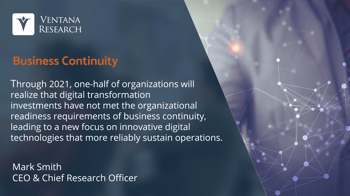
The business continuity imperative requires that organizations make it a priority to examine areas that are often overlooked and needed in the physical and virtual workplace but that make a meaningful impact on the workforce experience and HCM objectives. One such business area is engagement — leadership must support not just work processes but the needs of the workers, from compensation and benefits to straightforward processes and helpful technology.
Managing the work experience and human capital processes in a simple yet sophisticated manner is not as easy as it should be because many existing applications were not designed to provide quick and easy answers to questions. Effective engagement requires a process that provides digital and virtual information that’s consistent no matter the channel, from employee or workforce self-service applications and portals to digital collaborative tools used to communicate with HR and managers that support an organizations HR helpdesk needs.
It’s critical that organizations provide a digital experience that exceeds expectations, and this requires information that is easy to access and to update. The sustainability of every organization hinges on an effective workforce experience and technology investments that enable it to be interactive and fulfilling.
Building Continuity through Human Capital Management
Every organization should start by assessing all short- and long-term efforts related to the workforce experience related human capital management approach already in place. No matter where an organization manages worker information and knowledge of the skills and readiness of the workforce — whether from a dedicated approach such as an HCM system, or worse, from a tangle of custom applications — it must continuously improve the workforce experience. We assert that through 2022, one-half of organizations will realign HCM investments towards applications and tools that can directly improve the employee experience.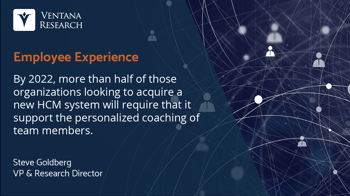
Furthermore, organizations that haven’t yet unified human capital management and moved it to the cloud must make this an immediate priority. It’s more difficult to prepare for the readiness of the workforce and the information needed when it’s not managed in a unified manner that ensures an acceptable level of resiliency for business continuity. It is essential to go beyond conventional wisdom; applications in the cloud and mobile access are basic steps in digital transformation, but that doesn’t mean that everything will be just fine, or your organizations will have the agility required. We have all witnessed the peril of this mindset. Many current approaches lack agility and require significant improvements in processes and technology. One example of this dilemma is learning management systems (LMS) that do not adapt easilly to the immediate needs for newer curriculum that was needed to support business continutiy. The learning paths needed across specific line-of-business departments and inevitable experience has been essential for organizations to the meet the workforce readiness and engagement required
Organizations should cultivate workforce information that encourages engagement — whether in the physical world or through digital efforts — to bolster more interactive workforce experiences. Doing this requires more intelligent, streamlined and automated workforce processes so employers and workers can focus on areas to engage and contribute effectively to objectives of the daily and weekly work.
An organization’s investment in its workforce and streamlining processes and systems to support them will determine its success and this is impossible without high-quality, seamless digital experiences. In fact, Ventana Research asserts that by 2022, one-half of organizations will determine that the digital experiences they provide are not intelligent or automated and fall short in maintaining business continuity for 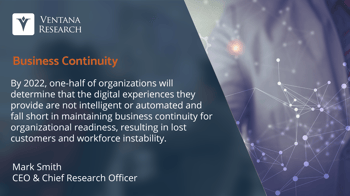 organizational readiness, resulting in lost customers and workforce instability. Organizations must effectively engage a workforce to be effective and build a strong, mutually invested team.
organizational readiness, resulting in lost customers and workforce instability. Organizations must effectively engage a workforce to be effective and build a strong, mutually invested team.
Success with business continuity is about more than just providing work schedules and posting new benefits information or supporting policy messaging. It’s not just about increasing levels of productivity and even sustaining those efforts in best and worst of times and under pressure and over time. Human capital management success is about increasing workforce readiness and satisfaction that delivers exceptional outcomes.
A clear understanding of human capital management requires a platform that can manage the workforce — roles, responsibilities, skills, desires and aspirations across the organization, no matter the classification of worker. In addition, organizations should seek an HCM platform that enables them to manage the organization, processes and interactions in a way that delivers desired results. This includes the use of AI through intelligent virtual agents (IVA) that can address a portfolio of simple questions involving benefits, pay and even work processes. The use of IVA is a logical extension of every HR helpdesk and support of employee and worker self-service needs. In addition all interfaces should ensure that employee information and interaction are secure, whether digital or live with such machines or actual managers or HR professionals. This requires a level of digital security to prevent cybersecurity risks.
Human capital management should do more than just enhance productivity for HR operations — it should have an impact on every worker. It should provide insights into critical metrics that indicate the health of the workforce including level of engagement to the readiness of them to perform work. A portfolio of critical people or workforce analytics should include forward-looking indicators to understand the variances in engagement that can lead to flight risk and worker readiness.
It’s also worthwhile to examine turnover and understand underlying factors and assess the relationship the worker experience in terms of the work, managers and workers’ satisfaction in their roles. But metrics and a dashboard alone are insufficient; the real value comes from applying machine learning and uncovering challenges and opporutnities for improvement and provide immediate guidance on issues and recommendations for resolution. These insights about the workforce must be easy to consume and if presented using natural language and stories can impact the value desired from HCM investments. Through effective notifications an organization can put intelligence in the hands of the people that matter. This next generation of people analytics that focus on the people analytics that focus on the digital experience that I recently provided in my perspective on how to use data and analytics to achieve organizational success.
The workforce experience unifies an organization’s efforts to not just sustain continuity but bring new value to human capital management efforts. It’s more about engagement than administration. Optimizing the workforce experience is more than just a nicety; it’s essential for every organization that looks to make the most of workforce engagement and relationships.
To maintain business continuity in HCM during challenging times, an organization may need to offer flexibility in work schedules and even the type of work performed. This effort is important whether the work environment is from home or on the front lines of a pandemic; organizations should seek to provide an experience that goes beyond what the workforce expects. Without an optimized workforce experience, an organization won’t be able to elevate the worker experience; I recently discussed why this is a critical part of your mission for business continuity and beyond.
Digital Workforce Communications is Essential
Managing workforce experiences requires not just the right applications but ones that enable unified digital communications and collaboration that supports the work experience that I have discussed previously. Challenges such as a global pandemic or natural disasters demand digital communication across a distributed and potentially virtualized workforce; however, crises often shift priorities and engagement can suffer. Being collaborative and responsive in communications is important and organizations must design a program that’s comprehensive across all channels and valuable to all parties. This is what resiliency and business continuity is all about.
Ventana Research asserts that through 2022, one-half of organizations will determine that their technology for unified communications is ineffective for meeting business continuity needs and falls short in the open communications requirements for secured and seamless interactions across devices and people.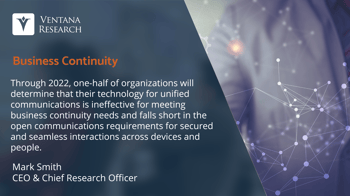
Organizations must ensure their digital communications can interoperate with the necessary applications and provide digital experiences that help engage the workforce directly and in the teams of workers that need it the most and are responsible for work. Organizations must enable digital collaboration among all parties in the workforce involved in the worker lifecycle to reduce friction and retain workforce. This collaboration as pointed out might be best addressed through conversational computing methods such as intelligent virtual agents, which are smarter than most bots and rapidly respond to the needs of the workforce and can also streamline response to communications.
Engaging an organization in new, virtual ways is essential to enacting work management methods that best support workforce processes. It’s important that an organization rally its digital communications efforts during a crisis such as a pandemic, because effectiveness in enhancing workforce processes requires collaboration across the organization to manage work in an intelligent manner. To be effective, organizations should establish best practices and policies that guide improvement to workforce experiences, enhancing virtual interactions with workers and managers and leadership for business continuity. This includes supporting direct engagement with HR to handle questions at time of need. And organizations must keep this axiom of business continuity in mind: Applications and systems must support digital communications with the workforce outside of normal operations and in a secured manner.
Workforce Experiences Matter
Many organizations have managed the workforce as they have customers, products and sales — across an array of business applications — but few of these applications support a dedicated focus on optimizing engagement by providing consistent experiences across a range of business processes. A quality workforce experience requires the right technology, which currently we don’t find in the legacy HR applications, or even in many of the current HCM approaches.
It’s important that an organization make investments into supporting HCM technology that uses an automated and intelligent approach to engaging the workforce, simplifying the execution of workforce-related tasks and activities to improve outcomes. The current movement in technology for HCM can help enhance the digital and virtual needs of the workforce using a common platform that can author and support endeavors to optimize interactions with the workforce, from full time to contractor.
It’s important that an organization make investments into supporting HCM technology that uses an automated and intelligent approach to engaging the workforce, simplifying the execution of workforce-related tasks and activities to improve outcomes.
Organizations must improve workforce experiences by assessing and prioritizing improvements to workforce processes to optimize engagement and readiness. Using the right technology is foundational to success and creates opportunities for breakthrough growth that far exceeds mere productivity improvements. The work-from-home and virtualization of the workforce efforts during a pandemic is a perfect example in how most organizations were not prepared and had to spend significant time as they had not prioritized business continuity. Sustainable growth in HCM and thus better workforce experiences are only possible when the organization is deliberate about the technology it uses to work collaboratively across the organization as well as with workforce and potential related parties that could be engagement with the organization from partners to suppliers. Organizations with a unified approach will find that it’s easier to achieve organizational agility when blended with digital communication platforms that are open and secure and that can help increase the velocity of engaging in and executing work.
Organizations also should prioritize investments that enable more effective digital engagement with the workforce to ensure worker readiness. Investments into return-to-work processes with dedicated applications is critical, especially during or following a pandemic, to ensure the health and safety of the workforce. Ensuring the ability to attest to good health and the mental readiness of the workforce is essential. In addition, understanding the location of employees at home and at work can help ensure the support for any contact tracing needs. And clearly, organizations must be prepared to respond to workforce needs, from healthcare to well-being. To do these will need methods that use mobile devices to virtualize worker interactions that use technology that supports workflw and robotic process automation (RPA) that can streamline the needs to meet the health and safety requirements, and the direct engagement of the workforce. And performing work whether in a facility or a living room, can further enhance the workforce experience, thus increasing likelihood of their visibility to your supporting their well-being.
Organizations should seek to establish or expand a Voice of the Workforce (VoW) program with a set of processes and technology that uses worker feedback and sentiment along with analytics and machine learning to gain insights to optimize workforce experiences. By 2022, only one-quarter of organizations will have a voice-of-the-workforce (VoW) program effective enough to improve workforce experiences. Organizations can better determine sentiment about the workforce experience by collecting feedback from workers at the time of daily engagement or when a benefit or service of the organization is utilized. If an organization is unable to capture and 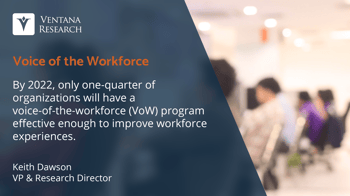 monitor interactions and online feedback from the workforce, then it’s probably missing the insights it requires to effectively improve the workforce experience. Continuous feedback can help increase productivity but, more importantly, the effectiveness of the organization. Additionally, sharing digital feedback such as worker reviews internally can instill confidence in the workforce.
monitor interactions and online feedback from the workforce, then it’s probably missing the insights it requires to effectively improve the workforce experience. Continuous feedback can help increase productivity but, more importantly, the effectiveness of the organization. Additionally, sharing digital feedback such as worker reviews internally can instill confidence in the workforce.
Smart Investments Matter
Organizations must consider whether investments in applications and technology that support workforce experiences can be utilized across channels and systems and if they’re built from a cloud-based HCM system. Supporting the “engage to provide” process is significantly different than traditional employee experience processes. The right HCM technology includes a platform and applications to support the portfolio an organization needs to facilitate the enterprise needs for the distributed, and during times of business continuity, virtualized workforce.
Investments should do more than automate HR functions in onboarding or benefits fulfillment. And this is why we assert that through 2023, one-third of organizations will initiate business continuity planning to realign the priority of technology investments required to operate seamlessly in a distributed and virtual manner in customer, product, supply chain and workforce processes.
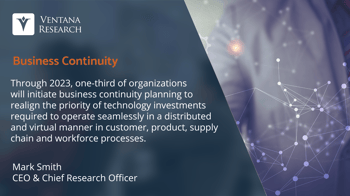 Smart investment requires an effective assessment of an array of applications and tools. A solid evaluation includes the following questions:
Smart investment requires an effective assessment of an array of applications and tools. A solid evaluation includes the following questions:
- Do your HCM technologies support the engagement and experience needed for your workforce across channels and systems?
- Do you have the workforce engagement processes to optimize experiences and increase worker satisfaction?
- Are you able to track engagement usage and provide insights to less than ready workers during a pandemic?
- Do you utilize an intelligent virtual agent (IVA) to provide immediate response to workers needs and issues?
- Can you manage your workforce readiness to manage engagement and experience targets?
- Do you have the return-to-work and work-from-home applications required to meet business continuity requirements?
- Are you able to have digital communications across the workforce in the organization — and in a secured and governed manner?
- Do you have the people analytics about your workforce that represent the spectrum of requirements from readiness to compensation retention?
- Can you monitor and engage your workforce with experiences that you can measure and methodically improve?
- Are you able to collaborate on specific tasks related to work to improve the quality of engagement and effectiveness of the workforce?
- Are you able to assess workforce satisfaction with a VoW program and use feedback to make improvements?
A “no” answer to any of these questions indicates risk that could directly impact an organization’s potential with its workforce. Every organization, no matter the industry, the number of its employees or the size, has an opportunity to significantly improve its workforce experience.
It’s critical that an application enable leaders and managers to adequately plan for and respond to needed changes, from black swan events to meeting typical business continuity obligations. Organizations are unwise to even consider any investments that aren’t mobile-ready and powered with collaboration methods across the workforce. We assert that by 2022, one-third of organizations will determine that their business applications are not suited to support their business continuity needs due to ineffective collaborative and mobile experiences, which are essential to operate 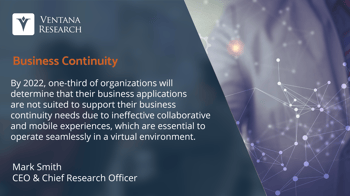 seamlessly in a virtual environment. Every organization must ensure it has technology that can operate on a mobile device and in a remote location, including from the couch and home office. Organizations should be ruthless about any operation that impairs the workforce experience. While organizations have spent significant resources and efforts on digital transformation in the form of automation and efficiency improvements, a far more important consideration is whether those investments provide the impact to the work desired and can support a focus on HCM that enables workforce experiences.
seamlessly in a virtual environment. Every organization must ensure it has technology that can operate on a mobile device and in a remote location, including from the couch and home office. Organizations should be ruthless about any operation that impairs the workforce experience. While organizations have spent significant resources and efforts on digital transformation in the form of automation and efficiency improvements, a far more important consideration is whether those investments provide the impact to the work desired and can support a focus on HCM that enables workforce experiences.
Partner with Finance
It’s difficult to overstate the importance of teamwork needed with finance when it comes to HCM and the engagement and retention of an effective workforce. This focus on workforce experience might be managed by the Chief HR Officer (CHRO) and should also be with the COO. Those in this role are tasked with looking at engagement and readiness of the workforce hired to perform roles no matter how small or large. In one way or another this is all related to costs and margins that are part of financial performance. Smart finance organizations have developed workforce models to assess any risk variables that can impact the organization’s ability to retain and optimize productivity of the workforce.
A successful workforce-focused organization goes further, embracing collaborative and continuous workforce planning for all aspects of their workforce, including recruiting, compensation, benchmarking, retention, as well as the recognition in potential bonuses, incentives and rewards for those who are responsible for contributing to health and performance. A focus on HCM and workforce experience is the foundation of both finance and operational leadership, but the “softer side” of the relationship with the workforce is just as important for ensuring business continuity and worker relationships.
The CFO and finance leadership need to actively support working closely with those who manage workforce relationships to examine potential investments that engage and improve the worker experience. Success requires engagement, not just fulfilling and responded to the requests of the workforce with operational efficiency. Similarly, legacy investments into HR and ERP to knit together workforce processes is insufficient, especially when it comes to the engagement and readiness of the workforce. For this reason, we assert that by 2022, one-half of HCM system buyers will consider a new HCM system only if it supports organizational readiness assessments.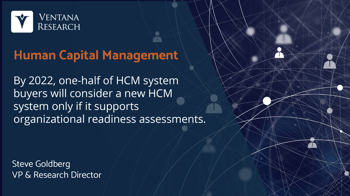
Unfortunately, finance might not understand HCM and the associated workforce applications nor the value they provide. Technology vendors might not have not done a great job marketing and selling their offering to the office of finance. This should not be an impediment for finance, but an opportunity for workforce and operations leadership to develop a working plan that unifies their efforts with a common platform and applications that optimize the workforce experience and maximize worker readiness to engage. And of course, this plan should include continuous workforce planning and analytics that helps model, benchmark and analyze the workforce from the entire lifecycle of the relationship with the organization. Executive teams and even boards of directors are responsible for ensuring that investments into the workforce experience and HCM will support the needs of today and in the future.
Next Steps
In times of crisis such as the current global health pandemic, when business continuity is a top priority, organizations mustn’t neglect digital investments in the workforce experience, especially if it has not previously been a focal point of executive leadership or a team involved with worker processes, whether recruiting, engaging and retaining them. A superior workforce experience demands technology that supports processes that improve productivity and the overall digital effectiveness in HCM. Leadership that invests in managing workforce and related processes can have a profound impact on worker engagement and an organization’s ability to reach expected productivity and performance expectations.
Continuous improvement is a shared responsibility across business and IT leadership, and impossible to do without HCM designed to optimize the engagement and experience of the workforce. This approach is not about technology for managing or providing information but the actual engagement and interactions with workers to meet their needs. It’s about a dedicated approach to HCM that’s focused on the experiences and processes related to the workforce and unfortunately many organizations continue to lack. Antiquated methods such as one-off extensions to an HCM, HRMS or payroll system are not always designed for the engagement more than just the administration and tracking of interactions and they certainly don’t provide a modern digital experience. One-off technology approaches can decrease productivity, diminish accountability and increase risk. It is critical that organizations, especially in times of duress, use business continuity as a driver to engage the workforce through the intelligent use of HCM systems, and thus should examine their investments in technologies.
If you are not sure how to approach improving the digital aspects of your HCM needs and workforce experience — and thus engagement and performance — through the lens of business continuity, there are specific steps that every organization should take, similar to the steps outlined in my perspective on the imperative for digital innovation in business continuity. The effective use of digital technologies can reinvent the workforce experience — for every worker no matter their relationship with the organization — requires the right lens that can support business continuity and not distract from it, which can ensure a more comprehensive approach. Most organizations have realized this and are making it a priority to be more prepared. We assert that by 2022, after a decade of concerted efforts in digital transformation, one-half of organizations will not have established business continuity as an investment priority and will not be prepared to operate in a future pandemic or crisis, which will lead to increased operational risks.
To achieve business continuity, optimize underlying workforce processes and technology for your organization as well as for your HCM efforts. This can have an immediate impact on top- and bottom-line results and reflects the priority you place on your workforce experience. Once your organization has an effective approach to digitally secure and open communications, along with the right tools for HCM and leadership committed to delivering an optimal workforce experience, you can be assured that your organization is built to last. Ensure that existing and future HCM technology investments are designed for effective engagement and a fantastic workforce experience, not just for automation and efficiency. The workforce experience is much more than just the digital, or the user experience (UX) of your existing applications.
Every worker matters, as does the internal team in your organization dedicated to designing the processes that support them. The entire executive team — the CEO’s staff, the CMO, CFO, CIO, CCO, COO, CRO, and the Chief Digital or Innovation Officers— should be aware of the strategy and plans for optimizing workforce and especially should be led by the CHRO or head of people and human resources. Organizational leadership needs to ensure they embrace HCM and the discipline it entails throughout the organization. The future depends on the active involvement of those who see building sustainable workforce experiences as fundamental to business continuity and determining the flexibility to engage and retain every worker.
Determining your path forward for 2020 and beyond requires an effective strategy and an understanding of how to best sustain the required business continuity for your organization. Make sure you are using applications and technology for HCM that can truly provide an effective workforce experience that’s focused on engagement and sustainable long-term relationships.
Regards,
Mark
Authors:

Mark Smith
Partner, Head of Software Research
Mark Smith is the Partner, Head of Software Research at ISG and Ventana Research leading the global market agenda as a subject matter expert in digital business and enterprise software. Mark is a digital technology enthusiast using market research and insights to educate and inspire enterprises, software and service providers.










